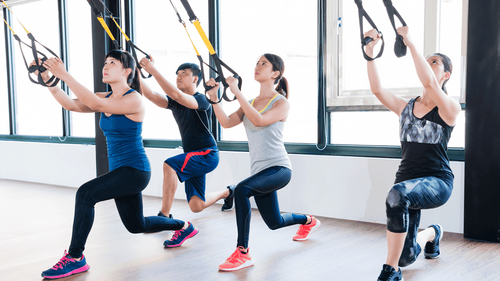This is an automatically translated article.
Muscle exercises, also known as strength or resistance exercises, are exercises that, when applied correctly, help prevent diabetes or aid in the treatment of diabetics. Simple movements performed regularly can prompt muscles to absorb more glucose (sugar) from the blood, which helps control blood sugar levels. These exercises will also burn more calories, helping to improve mood, cholesterol levels and blood pressure.
1.Diabetes exercise tips 1.1 General exercise advice for people with diabetes Most people with diabetes can exercise safely, but it is important to consult a doctor before starting. . You should do strength training at least twice a week, while cardio exercises - like running, swimming and cycling - 5 days a week for 30 minutes or 3 days a week 50 minutes each time. You should start exercises for diabetics at a light intensity and gradually increase the difficulty. Speak to a reputable trainer certified by sport bodies for specific advice.
1.2 Tips for Muscle (Strength) Exercises Get ready to learn these 10 at-home exercises that work your major muscle groups and utilize them to their fullest extent as a healing exercise. diabetes . For each exercise, start with a set where you do 8-15 reps with at least 30 seconds of rest between exercises. Start with a resistance band or light weights so you can focus on lifting and lowering the weights with controlled, rhythmic movements. When you can do two or three sets with ease, switch to a slightly heavier weight.
Watch now: Care, exercise, diabetes management in the elderly

Tư thế tấm ván (Plank) là bài tập chữa tiểu đường được nhiều người áp dụng
2. 10 muscle exercises to support diabetes control 2.1. Standing Biceps Curl The first diabetes exercise mainly affects the biceps muscle group. Holding a dumbbell in each hand, stand upright, palms facing thighs. Contract your biceps as you lift weights. On the way up, your forearms should rotate so that the palms are facing your shoulders when you reach the top position, then lower the dumbbells slowly back to the starting position. Try to keep your hands steady, avoid using inertia on the way down, control the movement from start to finish.
2.2. Triceps Extension The second diabetes exercise that works primarily on the back muscles of the arms. Stand with one foot slightly in front of the other, bringing your arms up to 2 elbows toward your back. Two hands holding a single dumbbell, holding position offset to a dumbbell head so that the direction of the dumbbell is parallel to the body on the back, lift the dumbbell slowly up. Straighten your elbows as you lift the dumbbells toward the ceiling, then bend your elbows and lower the dumbbells gradually behind your head to the starting position. Keeping the arms overhead and vertical to the floor, the shoulder blades should also be maintained in a downward and outward position after repeating the movement.
2.3. Shoulder Press (Shoulder Press) The third diabetes exercise works mainly on the shoulder muscle group, the position to perform this movement can be sitting or standing. The preparation position is that your elbows should be bent at a 90-degree angle, arms extended to the side, each hand holding a dumbbell with palms facing forward, dumbbells at ear level. The move is performed by alternately pushing the dumbbells up until your arms are fully extended and then slowly lowering them to the starting position.
2.4. Chest Press The fourth diabetes exercise works mainly on the pectoral muscle group. Lie on your back, knees bent and feet flat on the floor. Hold a dumbbell in each hand at chest level and raise them above your chest until your elbows are straight but not locked. Pause for a second and then slowly lower the weight toward your chest.

Gập bụng là bài tập chữa tiểu đường
2.5. Exercise for the back muscle group (Seated Row) The fifth diabetes exercise mainly affects the back muscle group. Sit on the floor with your knees bent, and place your feet so that your toes are extended and only your heels touch the floor. This exercise can use dumbbells or resistance bands, you can hold dumbbells in both hands or hold the end of the resistance band, arms straight out in front of you and palms facing each other. Keeping your back straight, bend your elbows as you pull the dumbbells or rope to the sides. Keeping your elbows close to your body then straighten your arms slowly back to the starting position.
2.6. Classic Crunch The sixth diabetes exercise mainly affects the abdominal muscle group. Lie on your back, feet flat on the floor, knees bent. The elbows are bent toward the back, the shoulder blades pressed together, and the hands behind the head. The elbows should point sideways and stay the same throughout the exercise. Squeeze your abs and arch your shoulders and upper back off the floor and slowly lower. Always keep your lower back pressed to the floor during the exercise.
2.7. Plank pose The seventh diabetes exercise mainly affects the abdominal muscles, back and buttocks. Lie on your stomach, elbows directly under your shoulders, palms down, and toes facing the floor. From this starting position, squeeze your abs, glutes, and back muscles as you lift your torso and thighs off the floor, holding this position for 5 seconds or more. You'll be supported by your toes and arms, keeping your back straight as you slowly lower to the starting position.
2.8. Exercises for the hip, butt, thigh muscle group (Squat) The eighth diabetes exercise works on the hip, buttock, thigh muscle group. Prepare to stand with feet shoulder width apart. Begin to slowly bend your knees and lower yourself as if you were sitting in an imaginary chair. Your thighs should be parallel to the ground and your knees should not be pushed forward beyond your toes. Lean forward slightly as you stand up. You can also do a squat while leaning against a stability ball placed between your back and the wall.
2.9. Lunges Exercise Ninth diabetes treatment mainly affects the leg muscle group. Stand with your feet shoulder-width apart and step your right foot back, bending your knee toward the floor without letting your knee touch, your left thigh should be nearly parallel to the floor. Press the left heel down and bring the right foot back to the starting position. Do 8-12 reps then switch sides with left foot stepping back. For more challenging lunges, hold a dumbbell in each hand.
2.10. Hamstring Curl The tenth diabetes exercise works mainly on the hamstring muscles. Do it by standing behind a chair with a backrest, holding the back of the chair with both hands. Bend your left leg and bend your knee, bringing your heel toward your butt, keeping your right leg slightly bent, then lower your left foot to the floor. Do this move 8-12 times on one side, then switch legs to balance the muscles on both sides. To make this exercise more difficult, ask your doctor if it is safe for you to wear ankle weights.

Bài tập chữa tiểu đường chùng chân (Lunges) tác động chủ yếu lên nhóm cơ chân
3. Some Diabetes Exercise Notes 3.1 Exercise Energy Notes If you are taking certain diabetes medications, you may need to take precautions. to avoid experiencing low blood sugar (hypoglycemia) – a very dangerous condition. Ask your doctor if you should check your levels or eat a snack before doing diabetes exercises. Carry snacks or small candy with you when you exercise in case you have symptoms of low blood sugar, such as tremors or muscle weakness.
3.2. Note for people on insulin therapy You may need to adjust your dose before and after doing diabetes exercises. Do an easy exercise to see how it affects your blood sugar. Monitor your blood sugar three times before, during and after exercise. If you exercise within an hour or two after a meal, your blood sugar may naturally drop to a certain extent and you may need to reduce your insulin dose during the immediately preceding meal. Before adjusting the dosage of any diabetes medication, including insulin, during an exercise program, you should consult your endocrinologist.
Properly applying the diabetes exercises suggested above can support blood sugar control to help prevent diabetes and control diabetes. Muscle (strength) exercises are not recommended for people with diabetes-related eye problems (such as diabetic retinopathy) being treated. If you have nerve damage in your feet, you may need to exercise while sitting or lying on the floor or learning to swim. If you're having complications from diabetes, a heart attack or a stroke, talk to your doctor first to get proper exercise advice.
Follow Vinmec International General Hospital website to get more health, nutrition and beauty information to protect the health of yourself and your loved ones in your family.
Please dial HOTLINE for more information or register for an appointment HERE. Download MyVinmec app to make appointments faster and to manage your bookings easily.













